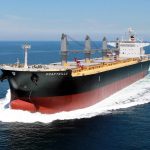The best way to deal with fires on board ships is to prevent them rather than letting them occur. Breaking out of fire in a place where no fire exist is called “ignition”, whereas “flash” is a term used for fire eruption in a new place as a result of flames from an existing fire in a nearby place (the ignition source).
Fires on board ships can be prevented by finding and rectifying leakages of fuel oil, lubricating oil, and exhaust gases.
In a ship’s generator room, the biggest danger of fire is from a leaky high pressure fuel pipe. Oil leaking from such pipe can fall on high temperature exhaust manifold or on indicator cocks, which are sensitive points for catching fire.
In modern marine engines, there is push-type cover concealing the indicator cocks; however in old engines there is no such provision available which makes it quite difficult to provide lagging to indicator cocks.

These days fuel high pressure pipes are sheathed and the leakage finds its way to a small tank at the bottom of the engine known as fuel leak off tank. It is imperative to keep this system in good order by regularly testing the tank alarm – fuel leak off tank high level alarm.
Leakages are mainly caused because of pipes breaking due to vibrations, clamps rubbing against pipes to create holes, pipe connections behind the pressure gauges getting damaged due to ageing (we generally do not look here), leakages from fittings at boiler furnace front and incinerator front etc. These leakages are some of the most common “hot spots” for fire. Moreover, careful and periodical checks are also required on boiler smoke side and incinerator uptake
Fires can be largely prevented by providing effective laggings to hot surfaces such as generator turbocharger bellows, main engine exhaust uptakes after the turbocharger, various steam pipes and pipes carrying hot oil. Laggings can be done by ship staff but these days specialist contractors are available to carry out this work more aesthetically. Also, whenever lagging is removed, a habit should be cultivated to put it back after the work is finished.
Apart from this, it is also important to check/test fire detectors on regular basis. Some of the main types of detectors used on ships are:
Flame detectors
Light produced by a flame has a characteristic flicker frequency of about 25Hz. The spectrum in the infra red or ultra violet range can be monitored to give an alarm. Oil fires generally do not give off much smoke and this type of sensor is preferred, especially near fuel handling equipment or boilers to give an early warning.
Heat detectors
Heat detectors are of various types such as rate of rise type, which has bi-metallic type detecting elements – a thick strip and a thin strip. The thin strip is more sensitive to temperature rise than the thicker one. If there is a sudden rise in temperature, the thin one bends faster than the thicker one, bringing both of them in contact.
During normal temperature rise both strips will deflect about the same amount and thus show no reaction. Normally if rate of rise is less than 10 deg C in half an hour, the detector will not give any alarm. If the rate should rise to 75 degree Celsius, or more, the two strips come in contact, thus triggering the alarm.
Smoke detectors
There are two main types of smoke detectors used
1) Light obscuration type
2) Ionization type Liquid or gas fires may not give off smoke initially but will catch fire spontaneously. Thus smoke detectors are not effective for such fires. These detectors are mostly used in accommodation areas.
Important points to consider for fire prevention on board ships
· In engine room, waste bins used for storing oily rags must have lids (covers). Oily rags should not stay lying around or stuck at unnecessary places. Receptacles with covers should be provided at each floor and on both sides.
· High pressure fuel oil pipes should not be tightened to control a leakage while the engine is running. Also, oil shouldn’t be taken in to turbochargers during operation.
· Short sounding pipes should be kept shut with plugs. Never should they be left in open position for the sake of convenience. Cases have been reported wherein oil has spilled out from these short sounding pipes leading to accidents.
· Loose pet cocks /small cocks on common rail pipes should be checked for.
· Exhaust leakages and steam leakages should be promptly attended.
· Ship’s crew should be careful about galley fires, especially by keeping electrical equipment in good order. Senior officers should keep an eye in the galley when provision is being received because this is the time when galley remains unattended for a long time.
· One of the patent methods of fire prevention is effective and regular fire patrol. There is no method that can beat physical monitoring.
· Fire caused by cigarettes is still one of the most common causes of fire. All care should be taken to dispose cigarettes (using self closing ashtrays) and never should one smoke in bed.
· Fires have also caused during loading and unloading of cargo such as coal. For this reason, ship personnel must always discuss the characteristics of the cargo and preventive methods to be taken during safety meetings and weekly drills.
These are some of the main points one needs to consider for a safe environment on ship. This list might not feature all the methods to prevent fire; however it does provide a brief overview of how things are to be handled on board ships.


